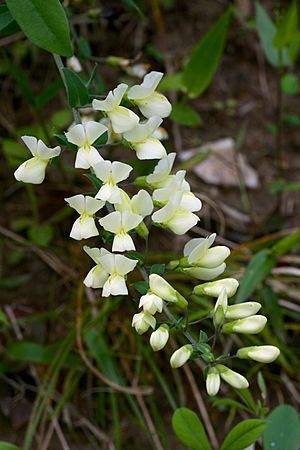Baptisia bracteata facts for kids
Quick facts for kids Baptisia bracteata |
|
|---|---|
 |
|
| Scientific classification | |
| Kingdom: | |
| (unranked): | |
| (unranked): | |
| (unranked): | |
| Order: | |
| Family: | |
| Subfamily: | |
| Genus: |
Baptisia
|
| Species: |
B. bracteata
|
| Binomial name | |
| Baptisia bracteata Elliot
|
|
Baptisia bracteata, also known as longbract wild indigo or cream false indigo, is a special kind of plant. It's a perennial, which means it lives for more than two years. This plant grows naturally in the central and eastern parts of the United States.
It's one of the first plants in its group, called Baptisia, to bloom each year. Its flowers start to appear as early as March in some areas. The blooms can be white or a creamy yellow color.
Contents
What is Baptisia bracteata?
Baptisia bracteata is a type of herbaceous plant. This means it has soft stems, not woody ones like trees. It's part of the Fabaceae family, which includes peas and beans. This plant is known for its unique flowers and how it grows.
Where Does It Grow?
This plant is native to a large area of the United States. You can find it growing in many states, especially in the central and eastern regions. It prefers open areas like prairies and woodlands.
When Does It Bloom?
One cool thing about Baptisia bracteata is how early it blooms. While many plants wait for warmer weather, this one can start showing its flowers in March. This makes it one of the first colorful plants to appear in spring. The flowers usually stay in bloom through April or May.
What Makes Its Flowers Special?
The flowers of Baptisia bracteata grow in clusters called racemes. Most other Baptisia plants have racemes that stand straight up. But Baptisia bracteata is different! Its flower clusters spread out sideways or even sprawl along the ground. This unique growth habit helps you tell it apart from its relatives.
Who Visits This Plant?
These beautiful flowers attract different kinds of insects. Bumblebees are often seen visiting the blooms. They help the plant by carrying pollen from one flower to another. This process is called pollination.
The leaves of Baptisia bracteata are also important for some insects. The caterpillars of several types of skipper butterflies eat the leaves. These include the wild indigo duskywing and the hoary edge skipper. These caterpillars munch on the leaves as they grow.
Is It Safe?
It's important to know that Baptisia bracteata is not good for animals to eat. It contains substances that can be harmful to plant-eating mammals. So, it's best to admire this plant from a distance and not let pets or livestock eat it.

